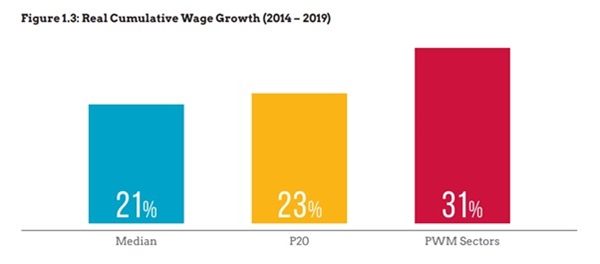We see these groups of people every day.
They keep our streets clean, our buildings safe, our gardens green. They do some of the most essential and sometimes unappreciated work so that we can comfortably get on with our daily lives.
Yet, for these groups of crucial workers, we often forget that the reward they get in return for their service is often not a good reflection of what they deserve.
Whenever we are asked, “Do you think they deserve better?” or “Should we help them upskill so that they can do more?” we instinctively respond with a resounding “Yes!”.
But have we considered what it truly takes to help uplift our lower-wage workers, and why we should?
Why We Must Help Lower-Wage Workers
Economic Growth
Studies have shown that boosting the wages of the lower-income groups leads to economic growth.
A report by the International Monetary Fund (IMF) in 2015 titled Causes and Consequences of Income Inequality: A Global Perspective said that if governments wanted to increase the pace of growth, they should concentrate on helping the poorest 20th percentile.
IMF wrote: “Our analysis suggests that the income distribution itself matters for growth as well. Specifically, if the income share of the top 20 per cent (the rich) increases, then GDP growth actually declines over the medium term, suggesting that the benefits do not trickle down. In contrast, an increase in the income share of the bottom 20 per cent (the poor) is associated with higher GDP growth.”
Breaking the Poverty Cycle
We should help our lowest earners break free from their poverty cycle.
Much like wealth, poverty too tends to be transferrable from one generation to the next. As a result, many lower-wage workers who hail from low-income families often find themselves trapped in this vicious cycle.
Caught between having to support sick or retired parents while raising children of their own, it is unlikely that they will achieve sufficient savings to invest in their children’s futures. As such, their children may end up repeating the cycle once again.
Closing the Income Gap
Growing the wages of our lowest 20th percentile to keep pace or surpass the median wage growth will be fraught with challenges, but it can and has been done.

Between 2014 to 2019, a report by the Tripartite Workgroup on Lower-Wage Workers (TWG-LWW) showed that through the efforts of the tripartite partners, the real cumulative income growth of the lowest 20th percentile outpaced the median by 2 per cent.
What’s more, sectors covered by the Progressive Wage Model (PWM) saw real cumulative income growth of 31 per cent, as opposed to the median growth of 21 per cent.
With this income growth, what can society expect over the next few years?
Cost of Living
Higher Wages, Higher Prices
For one, we as consumers must be willing to pay more for our goods and services.
It is fair to say that since businesses are paying their workers more, they will have to increase their prices, lest they want to let the increase in cost eat into their profits.
The act of uplifting wages does not just fall on the Government or employers alone – it requires a whole of society effort to make it work.
Better Standard of Living
With the higher cost of living comes a better standard of living.
And we are not just talking about the lower-wage workers who are getting higher wages, but for all in society as well.
While the lower-wage workers would be able to afford themselves and their families better medical care and education, the rest of the population should see improved productivity and efficiency in the services rendered to us.
Cleaner streets, safer buildings, greener gardens and much more.
That is if the PWM works as intended.
Equality is about making sure that everyone has an equal opportunity to make the most of themselves.
Our belief in equal opportunities is the main reason why we must close the income gap between our lowest-paid workers and the national median salary. We owe to our lower-wage workers the same opportunities in life that everyone rightfully deserves.

